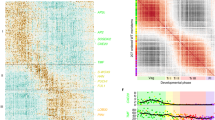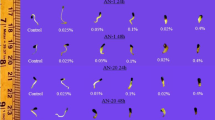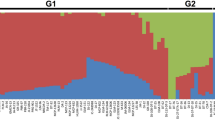Summary
Inflorescence morphology is a major discontinuity among Nicotiana rustica varieties and is controlled by major genes at, at least, two loci, which display duplicate non-allelic interactions. Its contribution to continuous variation for final height has been examined in F1, F2 and backcross families of a diallel set of crosses among eight inbred lines and in the F9 families of one of the crosses. It makes no direct contribution, but if all plants are divided into mop and non-mop types of inflorescence most of the variation in final height within each type can be accounted for by the variation in flowering time. Inflorescence morphology appears to switch the correlation between flowering time and final height from a very high negative value within the mops to a very high positive value within non-mops. Most of the non-allelic interactions for final height occur in crosses between a mop and a non-mop parent.
These results imply that the major genes controlling inflorescence morphology exercise a critical control over the continuous variation for final height. However, to explain the lower correlations in the F9 families and the positive correlations among mop head varieties not included in the diallel it is necessary to assume that allelic differences at loci that are not concerned with inflorescence morphology are also involved in the switch.
Similar content being viewed by others
Article PDF
References
Boughey, Hilarie. 1978. Competitive ability and environmental sensitivity in Nicotiana rustica. Ph.D thesis, Univ. of Birmingham.
Boughey, Hilarie, and Jinks, J L. 1978. Joint selection for both extremes of mean performance and of sensitivity to a macroenvironmental variable. III. The determinants of sensitivity. Heredity, 40, 363–369.
Boughey, Hilarie, Jinks, J L, Coombs, D, and Shufflebotham, W. 1978. Joint Selection for both extremes of mean performance and of sensitivity to a macroenvironmental variable. IV. Growth pattern and sensitivity. Heredity, 41, 175–183.
Caten, C E. 1977. Genetical and physiological analysis of continuous variation in fungi. Heredity, 39, 429.
Gale, M D. 1977. Genetic analysis and the control of development of height in wheat. Heredity, 39, 429.
Gale, M D, and Marshall, G A. 1975. The nature and genetic control of gibberellin insensitivity in dwarf wheat grain. Heredity, 35, 55–66.
Hill, J. 1964. Effects of correlated gene distributions in the analysis of diallel crosses. Heredity, 19, 27–46.
Hill, W G, and Avery, P J. 1978. On estimating number of genes by genotype assay. Heredity, 40, 397–404.
Jinks, J L. 1954. The analysis of continuous variation in a diallel cross of Nicotiana rustica varieties. Genetics, 39, 767–788.
Jinks, J L. 1956. The F2 and backcross generations from a set of diallel crosses. Heredity, 10, 1–30.
Jinks, J L, and Jones, R M. 1958. Estimation of the components of heterosis. Genetics, 43, 223–234.
Jinks, J L, and Towey, P M. 1976. Estimating the number of genes in a polygenic system by genotype assay. Heredity, 37, 69–81.
Kempthorne, O. 1977. In Proceedings of International Conference on Quantitative Genetics, ed. E. Poliak, O. Kempthorne and T. B. Bailey, Jr. Iowa State Univ. Press, Ames.
Mather, K. 1949. Biometrical Genetics. 1st edn. Methuen, London.
Mather, K. 1967. Complimentary and duplicate gene interactions in biometrical genetics. Heredity, 22, 97–103.
Mather, K, and Jinks, J L. 1971. Biometrical Genetics. 2nd edn. Chapman and Hall, London.
Mather, K, and Jinks, J L. 1977. Introduction to Biometrical Genetics. Chapman and Hall, London.
Oliverio, A. 1974. Genetic factors in the control of drug effects on the behaviour of mice, in Genetics of Behaviour, ed. J. H. F. van Abeelen, pp. 375–395. North Holland Publishing Co., Amsterdam.
Towey, P M, and Jinks, J L. 1977. Alternative ways of estimating the number of genes in a polygenic system by genotype assay. Heredity, 39, 399–410.
Author information
Authors and Affiliations
Rights and permissions
About this article
Cite this article
Jinks, J., Coombs, D. The relationship between major gene controlled inflorescence morphology and continuous variation for final height in Nicotiana rustica. Heredity 42, 299–307 (1979). https://doi.org/10.1038/hdy.1979.33
Received:
Issue date:
DOI: https://doi.org/10.1038/hdy.1979.33



